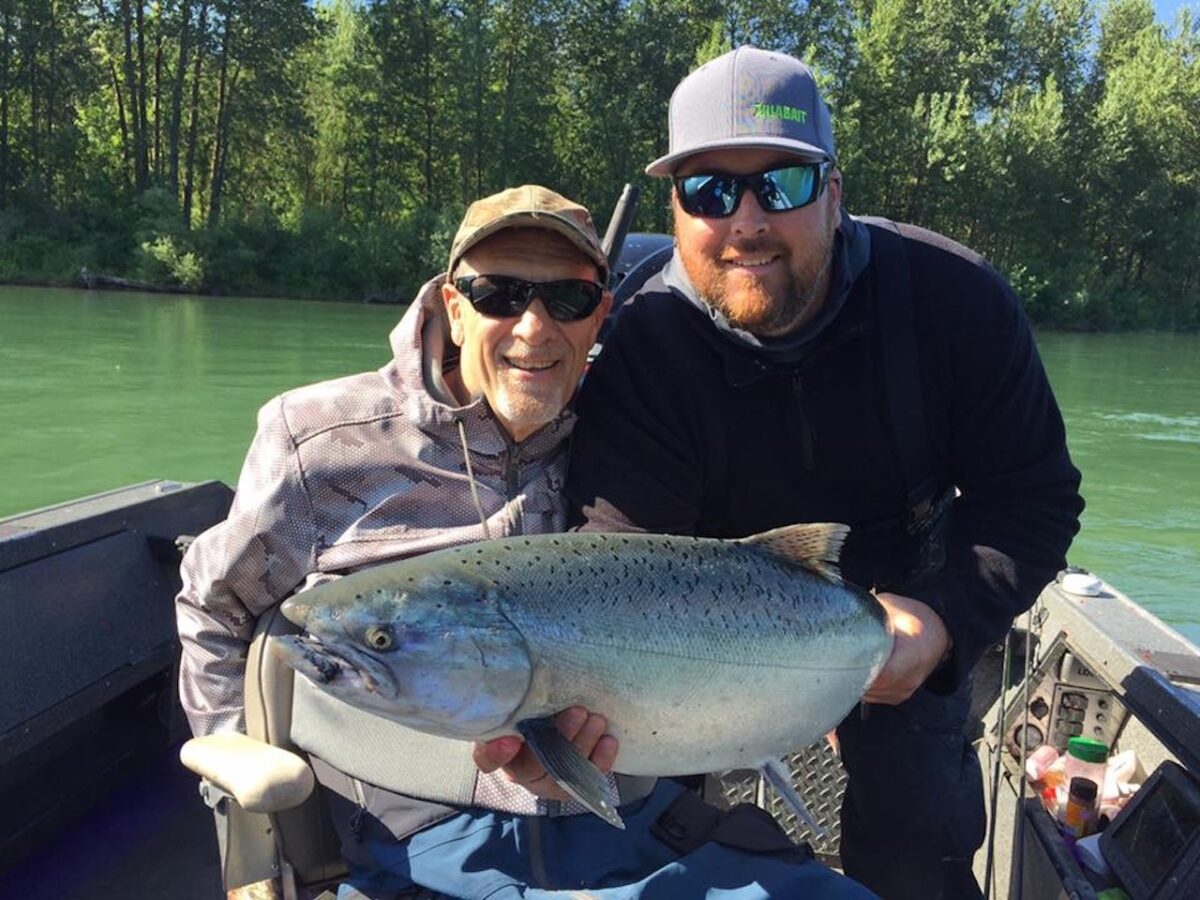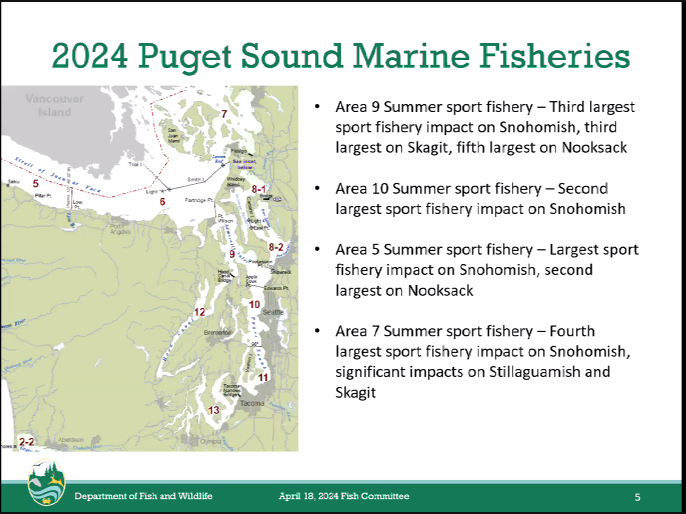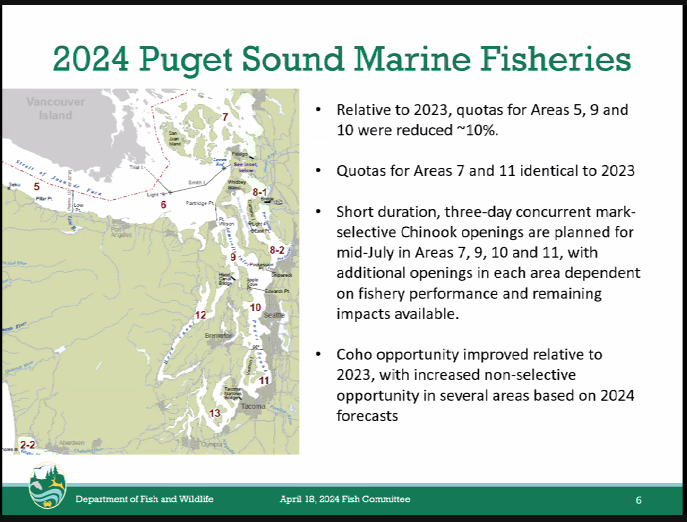
Skykomish Hatchery Chinook Fishery ‘Will Be Closed’ This Season
2024’s hatchery summer Chinook fishery on the Skykomish River will be even shorter than last year’s three-day late-May affair: There won’t be one.
Fishing for marked kings on the popular river east of Everett “will be closed,” WDFW Fish Program Director Kelly Cunningham told members of the Washington Fish and Wildlife Commission’s Fish Committee this morning during a briefing on outcomes from the recently concluded North of Falcon salmon-season-setting process.

It will be extraordinarily frustrating – albeit it not entirely unexpected – news for Skykomish anglers because of the large number of hatchery fish expected back this year that they won’t be able to tap into – 8,400, far more than is needed for broodstock purposes.
“Frustrating to say the least!” said Mark Spada, a longtime local angler and member of the Snohomish Sportsmen’s Club. “Especially when you consider that there is no data that shows there is any Snoqualmie Chinook in the Sky.”

According to Cunningham, the closure is due to the low number of Snohomish River wild fall Chinook returning to the Sky’s neighbor, the Snoqualmie.
After Alaska, British Columbia, Washington Coast and Puget Sound fisheries all take their whacks out of them, the Snoqualmie portion of the run is modeled to fall below what’s known as the “lower bound threshold” – 700 fish. Under the Puget Sound management plan for the Endangered Species Act-listed population that WDFW and the comanagers use, heavy fishery restrictions are required when that happens.
WDFW also trimmed 10 percent off of last year’s hatchery Chinook quotas for Marine Area 5, 9 and 10 fisheries this summer in response. Cunningham said that those areas in the central Strait of Juan de Fuca, Admiralty Inlet and central Puget Sound account for the three highest impacts on Snohomish Chinook as multiple king stocks mix with one another in the salt as they head to their natal rivers.

The state and tribes are aiming to keep the exploitation rate on Snohomish Chinook in what are known as Southern U.S., or SUS, fisheries below 8.0 percent. WDFW has little say in how British Columbia – which takes the heaviest single toll on the stock, per the management plan – operates its fisheries.
WDFW did make it clear from the get-go of North of Falcon 2024 that initial fishery modeling showed Snohomish wild Chinook would be a fishery-constraining stock this year and brought it up multiple times over the following weeks.
Still, the agency posted early on, “The initial number of fishing days in the Skykomish River is uncertain but is currently modeled at 22 days for summer hatchery Chinook.”
That looks more and more preposterous, and I warned in an early March blog about the ramifications of falling into the lower bound threshold.
It all left Spada fuming.
“Crazy to think that somehow the Snohomish system has been allowed to be governed as an aggregate, rather than by individual river systems,” he said, adding that that was “moronic, at best.”
“Oh, and by the way, let’s not forget the thousands of hatchery Chinook bound for the Wallace, that will never be harvested,” Spada said, prophesying that the issue won’t be going away anytime soon and may become ever tougher.
Late in the day, WDFW officials posted a long explanation about the situation on their Medium blog.
For some, this is becoming an increasingly familiar story. Last May’s three-day-only hatchery Chinook fishery on the Sky was due to one of the Snohomish wild king segments falling into the management plan’s lower abundance threshold, or LAT, and which also led to constraints on hatchery summer steelhead and coho and pink salmon seasons throughout the watershed.
WDFW’s proposed 2024-25 seasons also show no opener for coho on both the Skykomish and Snoqualmie. That would be to prevent incidental catches of wild Chinook, which linger on the spawning grounds into fall.
Lower in the system, coho are proposed to open from the mouth of the Snohomish up to the Pilchuck on September 21, the stretch from the Pilchuck to the confluence of the Sky and Snoqualmie on October 1 and the Wallace October 15.

Cunningham also talked to the commission’s Fish Committee this morning about other elements of 2024’s proposed salmon seasons.
Hatchery summer Chinook seasons on Marine Areas 7, 9, 10 and 11 will all open in July on concurrent three-day, Thursday-Saturday windows to spread out effort and attempt to extend the season as long as possible, he said.
He outlined new rules to address “disorderly fisheries.” On the lower end of the Samish, only bait and a single hook will be allowed, and the maximum hook gap between point and shank will be half an inch.
The Minter Creek estuary will also be closed to fishing at low tide like some other Kitsap Peninsula and Hood Canal streams.
Correction, 12:27 p.m., April 18, 2024: Though WDFW’s proposed regs for the Naselle indicated that snagged salmon would count toward the daily limit and boats would be banned on part of the river above the hatchery, WDFW Fish Program Director Kelly Cunningham said the agency was “not implementing those rules” after all. A story in the Chinook Observer earlier this month indicated that the proposals were an attempt to dissuade snagging. Last November, David H. Gretzner was sentenced to more than seven weeks in jail, was fined $1,500 and lost his fishing license for five years for a history of snagging on the Naselle.
